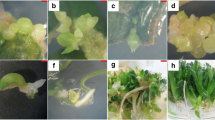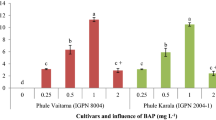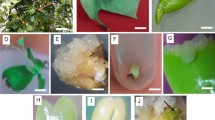Abstract
Various leaf sections of Gasteria verrucosa Haw. and Haworthia fasciata Haw. were cultured on media to examine the effect of picloram (4-amino 3, 5, 6-trichloropicolinic acid) and 2, 4-D (2, 4-dichlorophenoxy acetic acid) on somatic embryogenesis. Picloram (0.5, 1.0, 2.0, 3.0 mgl-1) outperformed 2, 4-D (0, 1.0, 2.0, 3.0 mgl-1) as the auxin source of both earliness of callus and embryo induction and final yield of embryos produced at both kinetin levels examined (0.25, 1.0 mgl-1). Embryos arose initially as a yellow, compact globular masses from the area just beneath the epidermis in linear pattern parallel with the main axis of the leaf and then developed a heartshaped appearance. Embryo formation was preceded by growth of callus almost crystalline in appearance on the cut surface. Subsequent shoot formation developed from green pigmented loci in crystalline callus derived from embryos. Shoot and root development in Gasteria was induced on a defined medium containing quarter strength MS or B5 salts with no hormonal supplementation.
Similar content being viewed by others
References
Collins GB, Vian WE, Phillips GC (1978) Use of 4-amino-3, 5, 6-trichloropicolinic acid as an auxin source in plant tissues. Crop Science 18:286–288
Goodin JR, Becher FLA (1967) Picloram as an auxin substitute in tissue culture. Plant Physiol (Suppl) 42:S-23
Hamaker JW, Johnston H, Martin RT, Redemann CT (1963) A picolinic acid derivative: A plant growth regulator. Science 141:363
Kaul K, Sabharwal PS (1972) Morphogenetic studies on Haworthia: Establishment of tissue culture and control of differentiation. Am J Bot 59:377–385
Kaul K, Sabharwal PS (1973) Morphogenetic studies on Haworthia: Effects of inositol on growth and differentiation. Am J Bot 62:655–659
Kefford NP, Caso OH (1966) A potent auxin with unique chemical structure-4-smino-3, 5, 6-trichloropicolinic acid. Bot Gaz 127:159–163
Kemp TR, Stoltz LR (1981) Endogenous cytokinin activity during the growth of cytokinin and auxin autonomous Haworthia mirabilis tissue in virtro. Hort Science 16:88
Majumdar SK (1970) Culture of Haworthia inflorescences in vitro. J South African Bot 36:63–68
Majumdar SK (1970) Production of plantlets from the ovary wall of Haworthia turgida var. pallidifolia. Planta 90:212–214
Ogihara Y, Tsunewaki K (1978) Tissue culture in Haworthia I. Effects of auxins and kinetin on callus growth. Bot Mag Tokyo 91:83–91
Ogihara Y (1979) Tissue culture in Haworthia II. Effects of three auxins and kinetin on greening and redifferentiation of calluses. Bot Mag Tokyo 92:163–171
Steel RGD, Torrie JH (1960) Principles and procedures of statistics. New York: McGraw-Hill
Wessels DCJ, Groenewald EG, Koeleman A (1976) Callus formation and subsequent shoot and root development from leaf tissue of Haworthia plantifolia. Z Pflanzenphysiol 78:141–145
Author information
Authors and Affiliations
Rights and permissions
About this article
Cite this article
Beyl, C.A., Sharma, G.C. Picloram induced somatic embryogenesis in Gasteria and Haworthia . Plant Cell Tiss Organ Cult 2, 123–132 (1983). https://doi.org/10.1007/BF00043357
Received:
Revised:
Issue Date:
DOI: https://doi.org/10.1007/BF00043357




